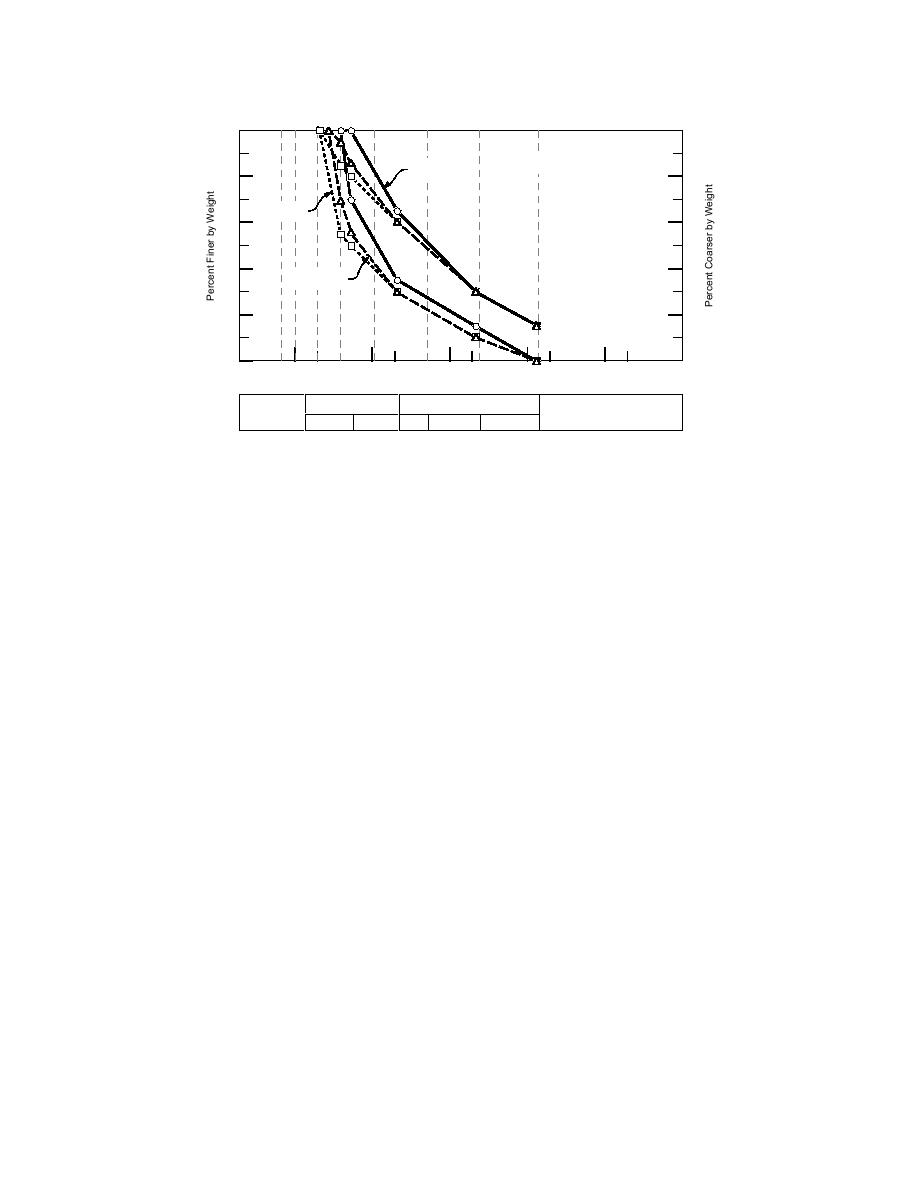
U.S. Standard Sieve Numbers
Hydrometer
6" 4"
2"
1"
10
40
200
3/8"
100
0
P-306 Econocrete Subbase Course
25 mm Max.
80
20
51 mm Max.
60
40
40
60
38 mm Max.
20
80
100
0
100
10
1
0.1
0.01
0.001
Grain Size (mm)
Gravel
Sand
Cobbles
Silt or Clay
Coarse
Fine
C'rse
Medium
Fine
h. P-306 Econocrete subbase course.
Figure 1 (cont'd). Grain size distribution limits.
cement specified can be ASTM (1992a) C150 Types
I, II, III, IV, or V. The soil must have no more than
minute pores and the amount of fines in the base
45% retained on the no. 4 sieve. Any gravel in the
course may not be significant enough to cause
soil must be smaller than 1 in. (2.5 cm). Test speci-
water to be drawn to the freezing front.
mens should be subjected to the ASTM (1992c,
1996) D559 and D560 durability tests for wetdry
P-212 shell base course
and freezethaw strength losses. At the end of 12
P-212 shell base course is made from reason-
wetdry or freezethaw cycles, the weight loss has
ably clean oyster or clam shells. Chemically, these
to be no more than 14% for granular materials,
shells form from calcium carbonate (CaCO3) pre-
10% for granular soils with some plasticity, and 7%
cipitate. Shell base courses were used under sev-
for clay soils. The compressive strength of the sta-
eral military airfields in the Gulf coast area in the
bilized material has to increase with age and
mid- to late-1950s. The strength of this material is
cement content.
probably lower than that of caliche or lime rock.
The specified gradation limits are shown in Fig-
P-304 cement-treated base course
ure 1e.
P-304 cement-treated base course is a mixture of
cement (portland cement or bitumen), water, and
P-213 sandclay base course
mineral aggregates. The aggregates can be crushed
P-213 sandclay base course is a mixture of
or uncrushed and meet the gradation limits in Fig-
clay and mineral aggregate. The mix can be a
ure 1g. The portland cement specified can be
sandclay, sandclaygravel, disintegrated gran-
ASTM (1992 a, b) C150 Types I, II, III, IV, or V or
ite or topsoil; however, the coarse portion of this
ASTM C595 Types IS, IS-A, IP, IP-A, P, or PA.
mix has to be gravel or stone. Two gradations are
Aggregates containing any amount of sulfates that
specified (Fig. 1f) based on the PI. Gradation A
has a PI ≤ 4% and gradation B a PI ≤ 6%. The liq-
would cause expansion of the cement-treated base
course by reacting with the alkalis in the cement
uid limit for both gradations is less than or equal
should not be used, or sulfate-resistant cements
to 25%. The PI limits in this specification appear
should be specified. If bitumen is used, either cut-
to be low for the allowable amount of fines (clay)
back (RC-70 and RC-250) or emulsified (RS-1, SS-1
passing the no. 200 sieve.
or CRS-1) asphalts are specified. The liquid limit
and PI of the blended material passing the no. 40
P-301 soilcement base course
sieve has to be less than or equal to 25% and less
P-301 soilcement base course is made from a
than 6% respectively. The 7-day compressive
mixture of soil, portland cement, and water. The
6



 Previous Page
Previous Page
